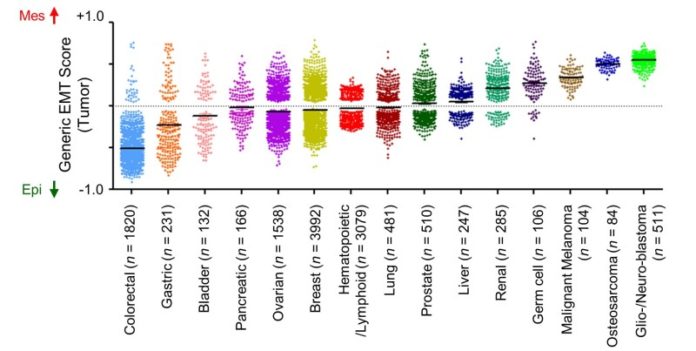
Scientists at the Cancer Science Institute of Singapore (CSI Singapore) at the National University of Singapore (NUS) and their collaborators have developed a scoring scheme that predicts the ability of cancer cells to spread to other parts of the body, a process known as metastasis. This system, which is the first of its kind, opens up the possibility to explore new treatments that suppress metastasis in cancer patients. The findings were published in EMBO Molecular Medicine in September.
Led by Professor Jean Paul Thiery, Senior Principal Investigator, and Dr Ruby Huang, Principal Associate, both from CSI Singapore, the scientists developed a scoring scheme which monitors the epithelial-mesenchymal transition (EMT) mechanism. This process was shown to play a role in a large number of cancer-related events, including cancer invasion, metastasis, and chemo-resistance. To date, there are no existing tools to systematically quantify the EMT status of tumors. The newly-developed EMT scoring is thus a promising, versatile tool for investigating EMT roles and dynamics in the progression, treatment response and survival across different types of cancer. It can also be integrated with other molecular tests, such as the detection of mutations of cancer genes, to help identify patients at higher risks for treatment failure and decreased survival.
EMT mechanism and cancer metastasis
Cancer metastasis is responsible for 90 per cent of cancer deaths. One of the mechanisms of metastasis is through the EMT process, where tumor cells lose adhesion contacts with their neighbouring cells at the primary tumor site, and gain the ability to move to a secondary site. The ability to stay in tight contact is an important feature of epithelial cells whereas the ability to gain movement is a characteristic of mesenchymal cells. tumor cells which undergo the EMT process lose their epithelial features and gain invasive, migratory properties typical of mesenchymal cells.
The EMT mechanism has a varying impact on different populations of cancer cells as they respond differently to the EMT cues. Not every cancer cell will undergo the same degree of loss of cell adhesion ability or gain the ability to move spontaneously, which is known as motility. As a result, tumors from different patients will exhibit a wide range of differences in the status of their EMT. To determine with precision the EMT status of the tumor, the research team developed a quantitative modelling system.
How the EMT scoring scheme was developed
In this study, the researchers utilised a total of 13,000 samples from publicly available databases containing gene expression information for more than 15 different types of cancers. A computational modelling scheme of EMT was established to define tumors having the most epithelial features and tumors having the most mesenchymal features. Subsequently, the tumors were rated on a continuous spectrum of different EMT scores. tumors with mixed epithelial and mesenchymal features are at the in-between state. This transitional state signifies cancer cell populations that might become truly mesenchymal. Patients who have tumors at this intermediate state may be at higher risks compared to those with tumors at the epithelial state.
The clinical information from the databases, including patient survival and treatment responses, was compared against the EMT scoring scheme. The research team showed that the EMT scoring they developed has a good correlation with previously published, cancer-specific EMT signatures. They used this scoring scheme to establish an EMT spectrum across various cancers and noted good correlation between cancer cell lines and tumors. The scientists concluded that this scoring scheme may enable the objective and systematic investigation of EMT in cancer progression, survival and throughout the clinical response to therapy.
Dr Huang said, “After announcing this generic EMT scoring scheme at an international cancer meeting in the United States, people came to me and thanked us for providing the field with a useful tool to help them determine EMT. Now, researchers no longer need to scratch their heads to find out what markers to use to represent EMT in their systems. We have provided the solution.”
“It’s about time that someone developed an EMT scoring scheme and we are very happy and excited that it came from our team,” said Prof Thiery. In 2002, Prof Thiery pioneered in indicating the role of EMT during cancer progression. As a result, this research field experienced an exponential growth in knowledge over the last 12 years, including implicating the current knowledge about cancer stem cells.
Future research
The scoring scheme has received interest from the scientific community and the team has started to compute EMT scoring for other researchers upon request. Currently, the team is developing a simplified diagnostic test to allow research or clinical labs to assess the EMT status of research or clinical samples.
Story Source:
The above story is based on materials provided by National University of Singapore. Note: Materials may be edited for content and length.
Journal Reference:
- T. Z. Tan, Q. H. Miow, Y. Miki, T. Noda, S. Mori, R. Y.-J. Huang, J. P. Thiery. Epithelial-mesenchymal transition spectrum quantification and its efficacy in deciphering survival and drug responses of cancer patients. EMBO Molecular Medicine, 2014; 6 (10): 1279 DOI: 10.15252/emmm.201404208
